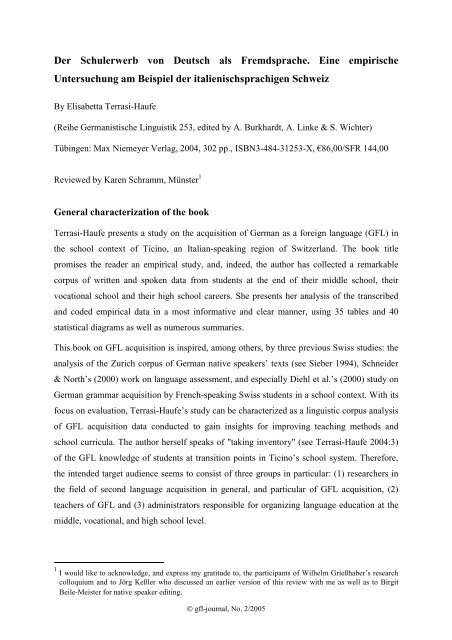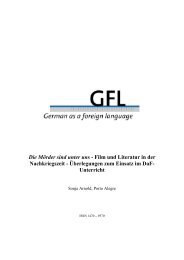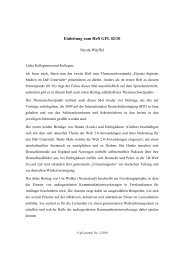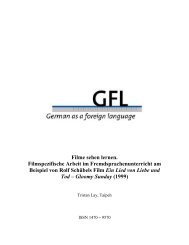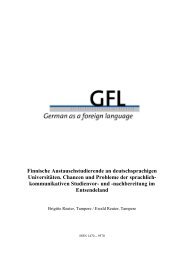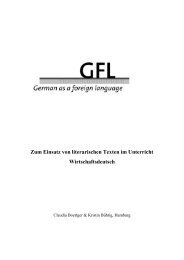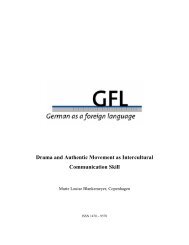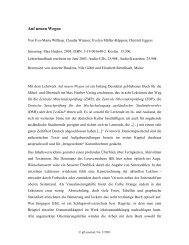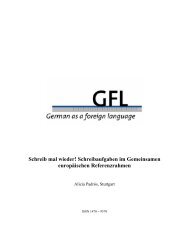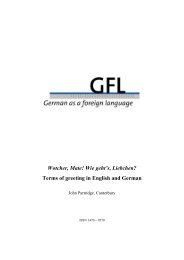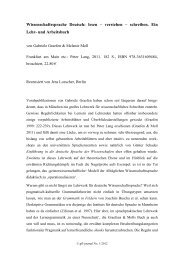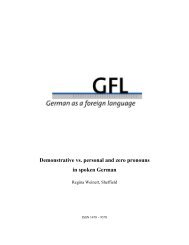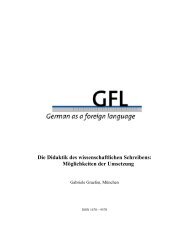Der Schulerwerb von Deutsch als Fremdsprache - GFL-Journal
Der Schulerwerb von Deutsch als Fremdsprache - GFL-Journal
Der Schulerwerb von Deutsch als Fremdsprache - GFL-Journal
You also want an ePaper? Increase the reach of your titles
YUMPU automatically turns print PDFs into web optimized ePapers that Google loves.
<strong>Der</strong> <strong>Schulerwerb</strong> <strong>von</strong> <strong>Deutsch</strong> <strong>als</strong> <strong>Fremdsprache</strong>. Eine empirische<br />
Untersuchung am Beispiel der italienischsprachigen Schweiz<br />
By Elisabetta Terrasi-Haufe<br />
(Reihe Germanistische Linguistik 253, edited by A. Burkhardt, A. Linke & S. Wichter)<br />
Tübingen: Max Niemeyer Verlag, 2004, 302 pp., ISBN3-484-31253-X, €86,00/SFR 144,00<br />
Reviewed by Karen Schramm, Münster 1<br />
General characterization of the book<br />
Terrasi-Haufe presents a study on the acquisition of German as a foreign language (<strong>GFL</strong>) in<br />
the school context of Ticino, an Italian-speaking region of Switzerland. The book title<br />
promises the reader an empirical study, and, indeed, the author has collected a remarkable<br />
corpus of written and spoken data from students at the end of their middle school, their<br />
vocational school and their high school careers. She presents her analysis of the transcribed<br />
and coded empirical data in a most informative and clear manner, using 35 tables and 40<br />
statistical diagrams as well as numerous summaries.<br />
This book on <strong>GFL</strong> acquisition is inspired, among others, by three previous Swiss studies: the<br />
analysis of the Zurich corpus of German native speakers’ texts (see Sieber 1994), Schneider<br />
& North’s (2000) work on language assessment, and especially Diehl et al.’s (2000) study on<br />
German grammar acquisition by French-speaking Swiss students in a school context. With its<br />
focus on evaluation, Terrasi-Haufe’s study can be characterized as a linguistic corpus analysis<br />
of <strong>GFL</strong> acquisition data conducted to gain insights for improving teaching methods and<br />
school curricula. The author herself speaks of "taking inventory" (see Terrasi-Haufe 2004:3)<br />
of the <strong>GFL</strong> knowledge of students at transition points in Ticino’s school system. Therefore,<br />
the intended target audience seems to consist of three groups in particular: (1) researchers in<br />
the field of second language acquisition in general, and particular of <strong>GFL</strong> acquisition, (2)<br />
teachers of <strong>GFL</strong> and (3) administrators responsible for organizing language education at the<br />
middle, vocational, and high school level.<br />
1 I would like to acknowledge, and express my gratitude to, the participants of Wilhelm Grießhaber’s research<br />
colloquium and to Jörg Keßler who discussed an earlier version of this review with me as well as to Birgit<br />
Beile-Meister for native speaker editing.<br />
© gfl-journal, No. 2/2005
Karen Schramm<br />
132<br />
Summary<br />
After a brief overview over the organization of the book in chapter 1, chapter 2 features a<br />
description of the research project. As important go<strong>als</strong> of the study the author points out<br />
insights about general and individual developmental sequences as well as about the<br />
interaction in the development of oral and written skills (see Terrasi-Haufe 2004:5). She goes<br />
on to describe the principles according to which she chose a preliminary sample of roughly<br />
440 students and according to which she reduced these data to a representative sample of 60<br />
subjects. This chapter <strong>als</strong>o describes the instruments and schedules used for collecting data,<br />
i.e. four written texts per student (letters, journal entries, stories, and articles) and three<br />
videotaped oral presentations and subsequent discussions per student (reports on private<br />
experiences, movies, books, and projects). Finally, chapter 2 <strong>als</strong>o reports on features of the<br />
employed software CLAN (see CHILDES, no year given) and on two key aspects of data<br />
entry, namely a transcription system for the oral data that the author developed herself (see<br />
Terrasi-Haufe 2004:19) and a system used for coding data on five different levels. These<br />
coding levels involve a data analysis of<br />
(1) specific morphological elements – based on the analysis tools of the Zurich corpus<br />
(Sieber 1994)<br />
(2) the parts of speech – based on the Duden classification (Drosdowski et al. 1995)<br />
(3) the parts of a sentence and of compound sentences – based on the Duden grammar as<br />
well (Drosdowski et al. 1995)<br />
(4) the linguistic action – based on a classification developed by Terrasi-Haufe using<br />
Austin (1962), Searle (1975), and Brandt et al. (1992, no reference given) and finally<br />
(5) orthographic, morphologic, syntactic, semantic, lexical and pragmatic errors – based<br />
on the analysis tools of the Zurich corpus (Sieber 1994)<br />
Chapter 3 proceeds to present the results of the qualitative and quantitative data analyses. For<br />
each of the three corpora of middle school, vocational school, and high school student data,<br />
this chapter provides detailed results of morphosyntactic, lexematic, and pragmatic analyses<br />
as well as of average sentence and text lengths. Some observations from Terrasi-Haufe’s<br />
study of verb forms shall serve to illustrate the nature of her findings (see Terrasi-Haufe<br />
2004:72). Students in grade 4 of the middle school are in the process of acquiring the past<br />
tense as well as the dual verb forms of modal verb/infinitive and perfect tense (German<br />
"Perfekt") as well as the past tense. At the end of their vocational school years, the majority of<br />
students are still acquiring participles and past tense forms although, in this heterogenous<br />
corpus, some are still struggling with subject-verb congruency while others are already<br />
dealing with subjunctive II (German "Konjunktiv II"). In grades 11 and 12, high school<br />
© gfl-journal, No. 2/2005
<strong>Der</strong> <strong>Schulerwerb</strong> <strong>von</strong> <strong>Deutsch</strong> <strong>als</strong> <strong>Fremdsprache</strong><br />
133<br />
students are mainly acquiring the passive voice and the different functions of the verb<br />
"werden". The author <strong>als</strong>o investigates general developmental tendencies concerning the<br />
nominal and pronominal declension system, syntactic complexity, and the use of parts of<br />
speech (verbs, nouns, pronouns, adjectives, adverbs, particles, conjunctions, and<br />
prepositions). In her pragmatic analysis, she investigates the range of linguistic actions used<br />
by the students, their use of procedures as defined by Ehlich (see Ehlich 1991) and their use<br />
of the modal field. She <strong>als</strong>o assesses the coherence of their productions, topic development,<br />
degree of explicitness and recipient guidance as well as aspects of their oral production (e.g.<br />
eye contact or gestures).<br />
Chapter 4 summarizes the results from a different perspective. The author reviews her most<br />
important insights according to student population and thus traces a reconstructed general<br />
developmental path. A minute exemplary detail from the pragmatic domain may illustrate<br />
Terrasi-Haufe’s encompassing approach: Whereas students’ linguistic actions at the end of<br />
middle school mainly consist of assertions, reports, and cognitive reasoning, their repertoire<br />
of assertive actions doubles in the first year of high school, and they begin to express attitudes<br />
(such as regret, astonishment and doubt) and to direct their hearers (with linguistic actions<br />
such as requests, advice, recommendations) (see Terrasi-Haufe 2004:180ff.).<br />
With its focus on student populations, chapter 4 provides a transition to the practical<br />
conclusions and recommendations for <strong>GFL</strong> instruction featured in chapter 5. A result<br />
particularly noteworthy to education administrators is that middle school students in Terrasi-<br />
Haufe’s corpus do not meet the go<strong>als</strong> defined in the school curricula for this level. In terms of<br />
teaching methodology, the author’s recommendations are primarily concerned with increasing<br />
explicit instruction on functional aspects of grammar and using examples of authentic<br />
communication in the classroom. The book <strong>als</strong>o contains an appendix of 79 pages showing<br />
the instruments used for data collection, transcription, and analysis.<br />
Evaluation<br />
Among the many strong points of this analysis, three aspects are to be mentioned in<br />
particular. First of all, Terrasi-Haufe has taken great care in creating a representative sample.<br />
To ensure a high-quality data base, she collected data from roughly 440 students and reduced<br />
these in two steps. In a first step, she selected only complete or virtually complete data series.<br />
This approach appears especially adequate since, for one of her three corpora, she followed<br />
students thoughout their transition from middle school to different vocational schools and<br />
© gfl-journal, No. 2/2005
Karen Schramm<br />
134<br />
high schools – an undertaking that, by its very nature, is otherwise prone to produce<br />
incomplete data. In a second step, she reduced her data series by randomly selecting a sample<br />
of 60 students. By collecting a set of data so much larger than the intended final corpus size,<br />
she was able to create a data base that is not only large for a study conducted by a single<br />
researcher, but <strong>als</strong>o unusually representative.<br />
Secondly, Terrasi-Haufe’s analysis is not only extremely labor-intensive in terms of<br />
transcribing and coding the data, but <strong>als</strong>o highly ambitious in its wide scope. As noted above,<br />
it goes beyond a description of morphosyntactical and lexical development to include<br />
pragmatic observations. To the reviewer, this approach seems highly promising for future<br />
research in the field of second language acquisition if it is conducted with instructional aims<br />
in mind. From this perspective, Terrasi-Haufe’s work can be considered as pioneering and<br />
will hopefully prove highly productive in generating further research into this important field.<br />
A third point worthy of praise is to be mentioned only very briefly, but might serve as an invitation<br />
to read Terrasi-Haufe’s work: The author presents her findings in a clear and precise<br />
manner. In addition to the wealth of detailed information it offers, the book is well-paced and<br />
straight-forward. Its high degree of accessibility deserves a wide audience.<br />
Some issues that the reviewer expects to be raised in discussions of this book are the validity<br />
of the oral data, the quality of the coding categories, and the theoretical implications of the<br />
empirical findings. With respect to the oral data, concerns about the validity will have to be<br />
addressed as Terrasi-Haufe (2004:174) notes that 40% of subjects read aloud their prepared<br />
presentations and another 25% of subjects delivered their presentations in a manner that it<br />
appeared to the researcher that they had memorized them. This means that, to a large extent,<br />
the oral corpus does not consist of spontaneous speech. Furthermore, parents or friends might<br />
have helped the subjects with their task of preparing the reports.<br />
In terms of data analysis, the quality of any corpus analysis depends to a great extent on the<br />
quality of the coding categories used. Therefore it comes as a surprise that Terrasi-Haufe does<br />
not discuss her specific reasons for relying extensively on the Duden grammar and the coding<br />
system developed for native speakers of German in Sieber (1994). As both of these coding<br />
bases are strongly norm-oriented, one wonders whether the author simply felt no need to<br />
reflect on the adequacy of their underlying assumptions. Also, coding is not a mechanic, but a<br />
highly interpretive analytic process (see Rehbein & Mazeland 1991). Terrasi-Haufe herself<br />
acknowledges problems with applying the norm-oriented coding categories (p. 19) and the<br />
creation of more or less spontaneous pragmatic categories during the coding process (p. 29).<br />
© gfl-journal, No. 2/2005
<strong>Der</strong> <strong>Schulerwerb</strong> <strong>von</strong> <strong>Deutsch</strong> <strong>als</strong> <strong>Fremdsprache</strong><br />
135<br />
The reviewer thus feels that several aspects of what the author merely calls "data entry" would<br />
have deserved more explicit reflection. Otherwise, the critical reader might experience<br />
difficulty in following specific coding decisions such as, for example, the coding of an<br />
omission of the subject in the following learner utterance "ich denke [...], dass [...] ist nicht<br />
schwierig [...], einen Beschluss zu fassen [...]" (Terrasi-Haufe 2004:20) or the decision to code<br />
norm-deviant realizations such as "auf ein genetisch Tomaten" (Terrasi-Haufe 2004:25) as<br />
masculine (thereby ignoring the option of neuter) on the basis that the first language, Italian,<br />
does not have a neuter gender. Finally, when Terrasi-Haufe develops a coding system for<br />
linguistic actions, similar concerns arise in that she does not spell out her underlying<br />
theoretical assumptions. For example, she appears to conceptualize her pragmatic analysis as<br />
an additional level added on to her lexical and morpho-syntactical research, even though this<br />
approach is not easily reconciled with the functional-pragmatic framework of Ehlich or<br />
Redder whose work she relies on.<br />
This leads us to a third point worthy of future discussion. A more explicit interpretation of the<br />
empirical findings in terms of theory development could prove of great interest to researchers<br />
in the field of second language acquisition. Terrasi-Haufe does establish some explicit<br />
connections of her rich description to other studies. However, it is generally not her priority to<br />
interpret her findings with respect to underlying processes or current theories of second<br />
language acquisition such as, for example, Pienemann’s (1998) processability theory,<br />
although this particular theory is highly relevant to her discussion of sequencing instruction<br />
according to acquisitional stages (see Terrasi-Haufe 2004:197). Readers who do not go along<br />
with her implicit assumption that the target language is the only option to use as a basis for<br />
the analysis of the data might remain curious about her explicit concept of learner language.<br />
In further discussion, the reviewer would welcome attempts to spell out more clearly such<br />
theoretical concepts underlying the coding categories and the discussions and to position the<br />
rich empirical description within the wider context of second language acquisition theory (e.g.<br />
Doughty & Long 2003) more explicitly. It goes without saying that all bibliographical<br />
references of such theoretical discussion need to be complete as well as correct, which<br />
unfortunately is not the case.<br />
Conclusion<br />
Terrasi-Haufe’s work is a valuable contribution to empirical research on <strong>GFL</strong> acquisition. It is<br />
based on a well-composed corpus, relies on extensive coding of empirical data, and uses<br />
© gfl-journal, No. 2/2005
Karen Schramm<br />
136<br />
powerful software for the data analysis. However, its wide scope of analysis requires some,<br />
arguably problematic, compromises concerning the categories employed, and this study thus<br />
comes close to testing the boundaries of what a one-person research project can accomplish.<br />
Hopefully, therefore, this important book will motivate further collaborative research to<br />
pursue the goal of pragmatic analyses of second language acquisition in school contexts<br />
which Terrasi-Haufe has clearly established and which is so highly relevant to reforms in<br />
language education.<br />
References<br />
Austin, J.L. (1962) How to do things with words. Oxford: Clarendon Press.<br />
CHILDES (no year given) Child Language Data Exchange System.<br />
http://childes.psy.cmu.edu, access on February 12, 2005.<br />
Diehl, E., H. Christen, S. Leuenberger, I. Pelvat & T. Studer (2000) Grammatikunterricht:<br />
Alles für der Katz? Untersuchungen zum Zweitspracherwerb <strong>Deutsch</strong>. Tübingen:<br />
Niemeyer.<br />
Drosdowski, G., P. Eisenberg, H. Gelhaus, H. Henne, H. Sitta & H. Wellmann (1995)<br />
DUDEN Grammatik der deutschen Gegenwartssprache. Mannheim: Dudenverlag.<br />
Doughty, C. & M.H. Long (eds.) (2003) The Handbook of Second Language Acquisition.<br />
Oxford: Blackwell Publishers.<br />
Ehlich, K. (1991) Funktional-pragmatische Kommunikationsanalyse – Ziele und Verfahren.<br />
In: D. Flader (ed.) Verbale Interaktion. Studien zur Empirie und Methodologie der<br />
Pragmatik. Stuttgart: Metzler, 127-143.<br />
Redder, A. (1995) Handlungstheoretische Grammatik für DaF am Beispiel des sogenannten<br />
„Zustandspassivs“. In: N. Dittmar & M. Rost-Roth (eds.) <strong>Deutsch</strong> <strong>als</strong> Zweit- und<br />
<strong>Fremdsprache</strong>. Frankfurt am Main: Lang, 53-74.<br />
Rehbein, J. & H. Mazeland (1991) Kodierentscheidungen. Zur Kontrolle interpretativer<br />
Prozesse bei der Kommunikationsanalyse. In: D. Flader (ed.) Verbale Interaktion.<br />
Studien zur Empirie und Methodologie der Pragmatik. Stuttgart: Metzler, 166-221.<br />
Pienemann, M. (1989) Is Language Teachable? Psycholinguistic Experiments and<br />
Hypotheses. In: Applied Linguistics 10(1)/1989, 52-79.<br />
Pienemann, M. (1998) Language Processing and Second Language Development:<br />
Processability Theory. Amsterdam u.a: Benjamins.<br />
Schneider, G. & B. North (2000) <strong>Fremdsprache</strong>n können – was heisst das? Skalen zur<br />
Beschreibung, Beurteilung und Selbsteinschätzung der fremdsprachlichen<br />
Kommunikationsfähigkeit. Chur/Zürich: Rüegger.<br />
Searle, J.R. (1975) A Taxonomy of Illocutionary Acts. In: K. Gunderson (ed.) Language,<br />
Mind and Knowledge. Minneapolis: University of Minnesota Press, 344-369.<br />
Sieber, P. (ed.) (1994) Sprachfähigkeiten – Besser <strong>als</strong> ihr Ruf und nötiger denn je! Aarau:<br />
Sauerländer.<br />
© gfl-journal, No. 2/2005


